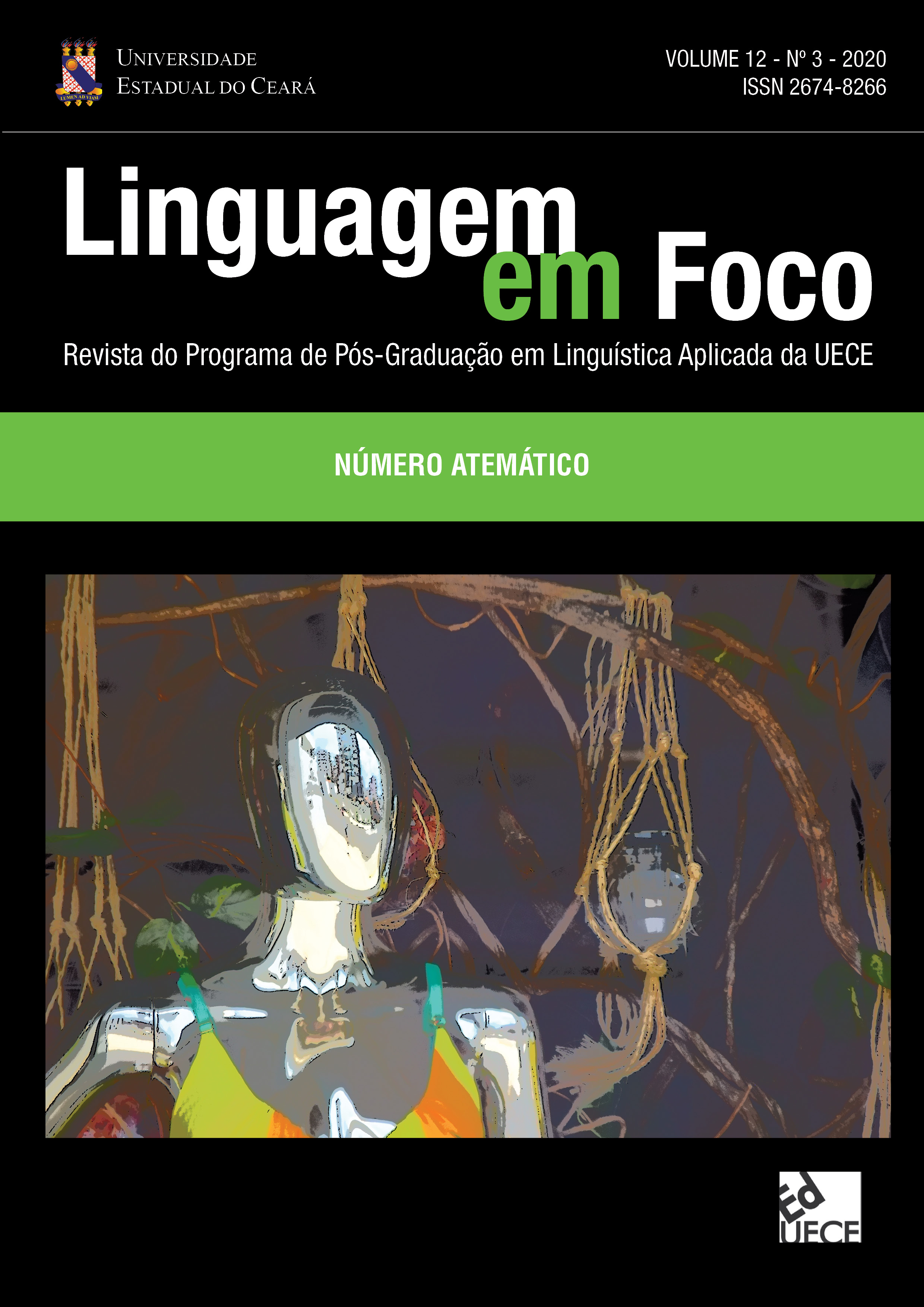Use of punctuation marks in the construction of textual meaning
DOI:
https://doi.org/10.46230/2674-8266-12-4372Keywords:
Punctuation marks, Discourse, MeaningAbstract
The study of the use of punctuation signs in the construction of textual meanings proposed here reflects upon the interference of those resources in marking of enunciative postures in journalistic texts. Observations made from the analysed corpus show that some punctuation marks, used in specific circumstances, do not function in relation to the syntactic structure of the text. As of this acknowledgement, the role that determined punctuation resources would play in a textual statement began to be investigated, once that their syntactic function would be non-existent. The research mostly bases itself in the studies of Catach (1994), Junkes (2002) and Dahlet (2006). The study characterizes itself as qualitative research based on the corpus analysis, that’s built out of fragments of journalistic texts collected from digital outlets. The results show the effective use of punctuation signing discursive postures on fragments, in which the purely syntactic aspects would not be effective or productive.
Downloads
References
ABREU, A. S. A arte de argumentar: gerenciando razão e emoção. 2. ed. Cotia, SP: Ateliê
Editorial, 2000.
BAKHTIN, M. Estética da criação verbal. Trad. do russo: Paulo Bezerra. 5. ed. São Paulo: WMF Martins Fontes, 2010b.
BAKHTIN, M. Para uma filosofia do ato responsável. Trad.: Valdemir Miotello e Carlos Alberto Faraco. São Carlos, SP: Pedro & João Editores, 2010a.
BAKHTIN, M. Questões de Literatura e de Estética. 6. ed. São Paulo: Hucitec, 2010c.
BARROS, D. L. P. Contribuições de Bakhtin às teorias do discurso. In: BRAIT, B. (Org.). Bakhtin, dialogismo e construção do sentido. 2. ed. Campinas: UNICAMP, 2005. p. 25-36.
BRAIT, B.; CAMPOS, M. I. B. Da Rússia czarista à web. In: BRAIT, B. (Org.). Bakhtin e o Círculo. São Paulo: Contexto, 2009. p. 15-30.
BRAIT, B.; MELO, R. de. Enunciado/enunciado concreto/enunciação. In: BRAIT, B. (Org.). Bakhtin: conceitos-chave. São Paulo: Contexto, 2005. p. 61-78.
BRUNDTLAND, G. H. et al. Nosso futuro comum. Comissão Mundial sobre Meio Ambiente e Desenvolvimento. 2.ed. Rio de Janeiro: Fundação Getúlio Vargas, 1991.
CONAR. Código de Autorregulamentação Publicitária. Anexo U – Apelos de sustentabilidade. 2011. Disponível em: <http://www.conar.org.br>. Acesso em: 23 ago. 2017.
FARACO, C. A. Linguagem & diálogo: as ideias linguísticas do círculo de Bakhtin. São Paulo: Parábola Editorial, 2009.
FIORIN, J. L. Interdiscursividade e Intertextualidade. In: BRAIT, B. (Org.). Bakhtin: outros conceitos-chave. São Paulo: Contexto, 2006. p. 161-193.
KNOLL, G. F. Multimodalidade, texto e contexto: categorias úteis à análise da charge. Revista (Con) Textos Linguísticos, v. 9, n. 12, p. 57-74, 2015.
KNOLL, G. F.; VELLOZO, L. dos S. Multimodalidade e Gênero Social na Publicidade: Representações de diversidade em anúncios. Cadernos de Comunicação, v. 23, n. 1, 2019.
KRESS, G. e VAN LEEUWEN, T. Reading images: the grammar of the design visual. 2. ed. London, Routledge, 2006.
MARCHEZAN, R. C. Diálogo. In: BRAIT, B. (Org.). Bakhtin: outros conceitos-chave. São
Paulo: Contexto, 2006. p. 115-131.
MELO NETO, F. P.; FROES, C. Responsabilidade social e cidadania empresarial: administração do terceiro setor. Rio de Janeiro: Qualitymark, 2004.
MIOTELLO, V.; TURATI, C. Para uma leitura do texto materialmente heterogêneo. Versão Beta, São Carlos, v. 55, p. 5-25, 2010.
PERELMAN, C.; OLBRECHTS-TYTECA, L. Tratado da argumentação: a Nova Retórica. São Paulo: Martins Fontes, 2005.
PETRILLI, S. Uma leitura inclassificável de uma escritura inclassificável. In: PAULA, L. de;
STAFUZZA, G. (Orgs.). Círculo de Bakhtin: teoria inclassificável. São Paulo: Mercado de
Letras, 2010. p. 31-88.
PISTORI, M. H. C.; BANKS-LEITE, L. Argumentação e construção de conhecimento: uma
abordagem bakhtiniana. Bakhtiniana, São Paulo, v. 1, n. 4, p. 129-144, 2. semestre/2010.
RABAÇA, C. A.; BARBOSA, G. Dicionário de comunicação. São Paulo: Ática, 2002.
ROCHA, E. P. Magia e capitalismo – Um estudo antropológico da publicidade. São Paulo: Editora Brasiliense, 1985.
ROCHA, R. B. da S. S. A escrita argumentativa: diálogos com um livro didático de
português. 2010. 193 f. Dissertação (Mestrado em Linguística Aplicada e Estudos da
Linguagem) – PUCSP. São Paulo, 2010.
SAMPAIO, Rafael. Propaganda de A a Z. Rio de Janeiro: Elsevier, 2003.
SANTANDER. Institucional. Disponível em: . Acesso em: 21 jan. 2016.
SCHNAIDERMAN, B. Semiótica russa. São Paulo: Perspectiva, 1979.
VEJA. Mídia Kit 2018. São Paulo, 2018. Disponível em: http://publiabril.abril.com.br/marcas/veja. Acesso em: 24 abr. 2018.
VOLOSHÍNOV, V. N. Marxismo e filosofia da linguagem: problemas fundamentais do método sociológico da linguagem. 13. ed. São Paulo: Hucitec, 2009.
Published
How to Cite
Issue
Section
License
Authors who publish in Linguagem em Foco Scientific Journal agree to the following terms:
- Authors retain the copyright and grant the journal the right of first publication. The articles are simultaneously licensed under the Creative Commons Attribution License which allows sharing the work with an acknowledgement of its authorship and initial publication in this journal.
- The concepts issued in signed articles are the absolute and exclusive responsibility of their authors. Therefore, we request a Statement of Copyright, which must be submitted with the manuscript as a Supplementary Document.
- Authors are authorized to make the version of the text published in Linguagem em Foco Scientific Journal available in institutional repositories or other academic work distribution platforms (ex. ResearchGate, Academia.edu).





























